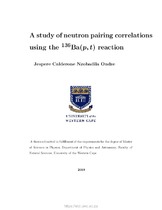| dc.contributor.advisor | Triambak, Smarajit | |
| dc.contributor.author | Jespere Calderone, Nzobadila Ondze | |
| dc.date.accessioned | 2021-12-01T13:48:00Z | |
| dc.date.available | 2021-12-01T13:48:00Z | |
| dc.date.issued | 2020 | |
| dc.identifier.uri | http://hdl.handle.net/11394/8590 | |
| dc.description | >Magister Scientiae - MSc | en_US |
| dc.description.abstract | Observation of neutrinoless double beta decay (0 ) is currently the only
means by which one could establish the Majorana nature of neutrinos. Additionally,
such an observation would determine the absolute neutrino mass
scale. However, this requires that the matrix element for a given 0 decay
process is accurately calculated. The objective of this project is to provide
useful nuclear structure information that aim to improve future theoretical
calculations for the nuclear matrix element (NME) of 136Xe 0 decay to
136Ba. We studied neutron pairing correlations in 134Ba using the 136Ba(p; t)
reaction to stringently test the Bardeen-Cooper-Schrie er (BCS) approximation
in the A = 136 mass region. This is because many theoretical calculations
of the NME's for 0 decay are performed using the quasiparticle
random phase approximation (QRPA), which uses the BCS approximation
to describe the ground states of the even-even parent and daughter nuclei.
Our results show a signi cant fragmentation of the neutron-pair transfer to
excited 0+ states, implying a breakdown of the BCS approximation in this
mass region. | en_US |
| dc.language.iso | en | en_US |
| dc.publisher | University of Western Cape | en_US |
| dc.subject | Neutrinoless double beta decay | en_US |
| dc.subject | Nuclear Matrix Element | en_US |
| dc.subject | Quasiparticle Random Phase Approximation | en_US |
| dc.title | A study of neutron pairing correlations using the 136Ba(p, t) reaction | en_US |
| dc.rights.holder | University of Western Cape | en_US |

